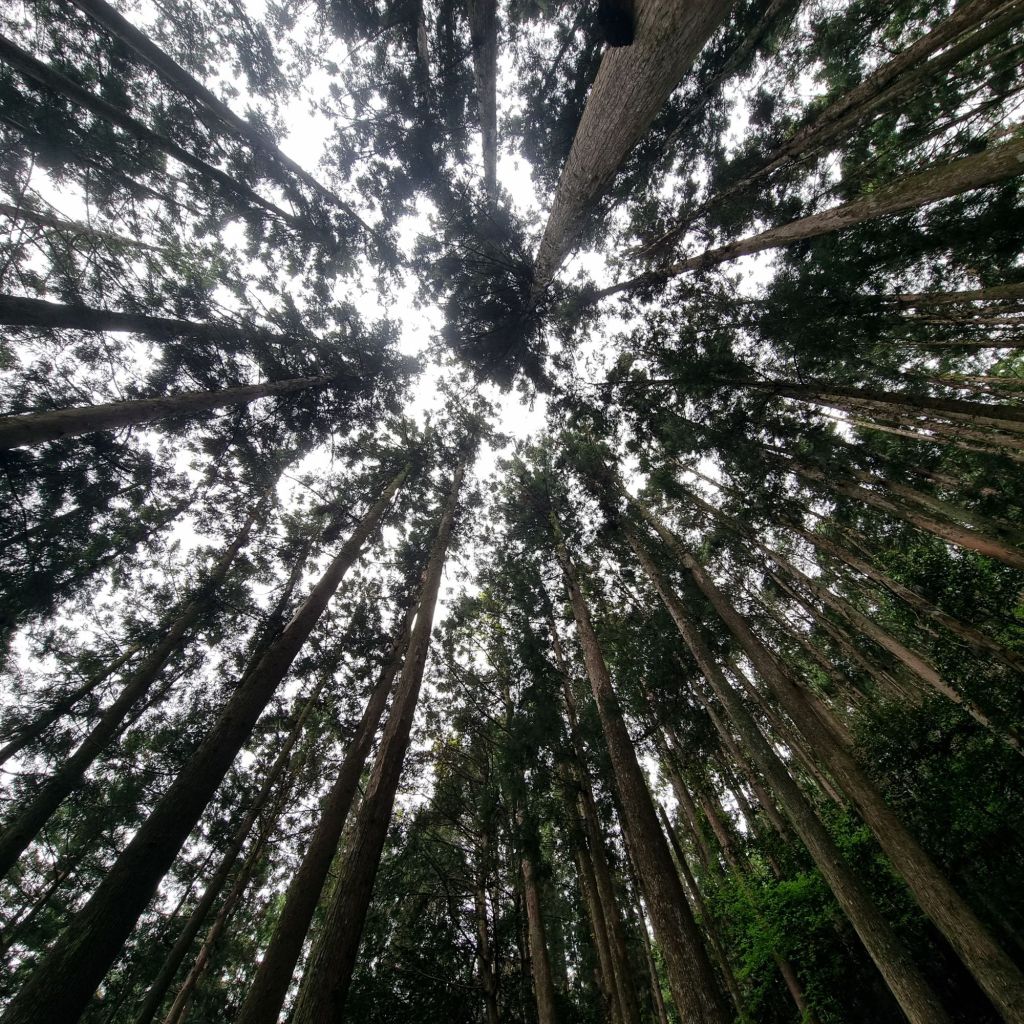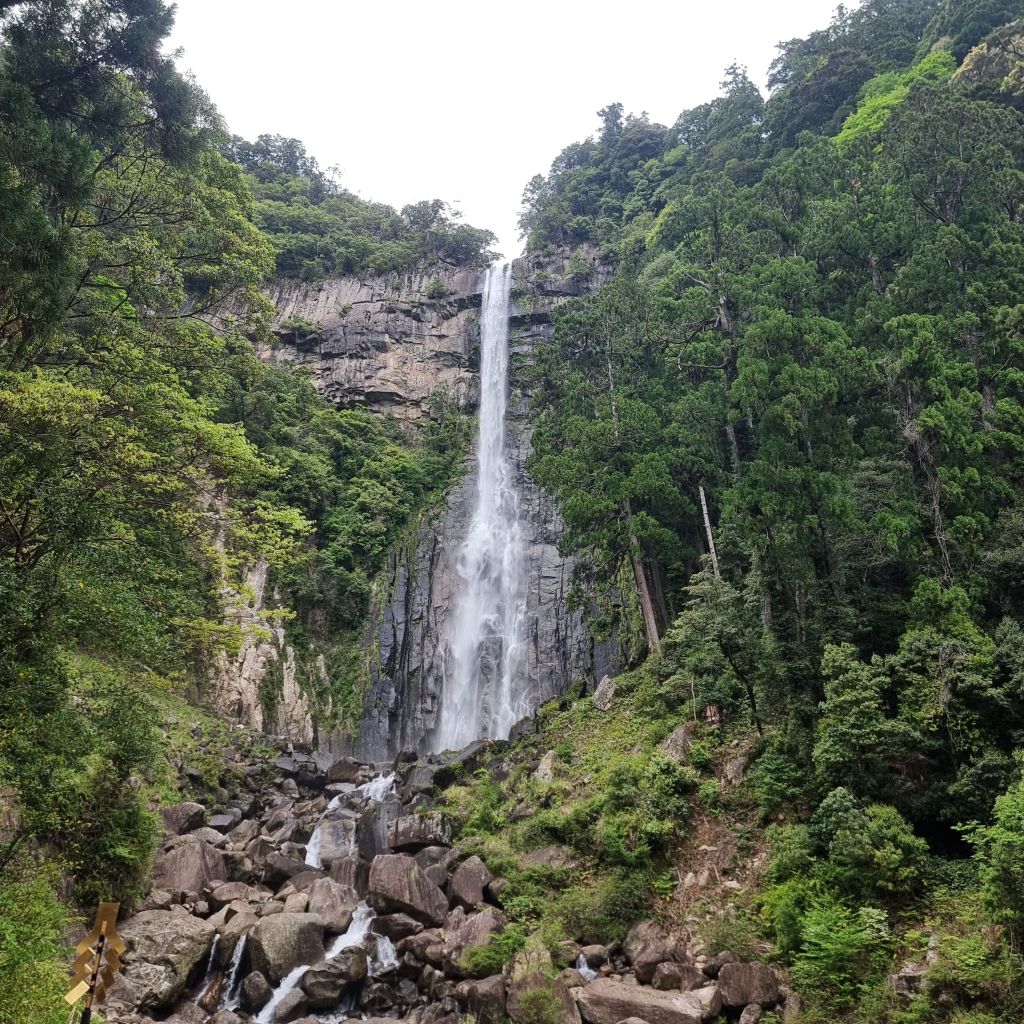Misty but not raining, and by the time the bus gets to the trailhead there are twelve other pilgrims walking the same way from Koguchi, so we string out onto the trail. This is the fourth stage of the Nakahechi route, and it’s considered to be the hardest walk.
It’s pretty easy to find the trailhead, particularly in company. There’s a little box for a stamp, where someone keeps the ink refreshed. Some of us stop, others are totally over the whole stamp thing by now. I think it’s cute so I get one, and Mae tells me I am stupid for not having walking poles, and that my T-shirt is cotton. She’s half my size and twice my age. I smile and show helpless hands. She smiles back and starts swarming up the hill. I never see her again.
The trail goes up into the clouds, over boulders that have been there for thousands of years, some surely dropped by glaciers, and through tree roots that will be shifting and probing, holding up the long straight cedars that line this ancient walk.


It is quiet here. The rush of water when there are streams, occasional woodpeckers, the calls of birds. I have been promised leeches and snakeses and bears, oh my. I find I’m disappointed at the lack of wildlife. Beautiful spiderwebs. A large ichneumon wasp lands on my arm with the long ovipositor that everyone mistakes for a sting. Nothing unpleasant all day.
This walk used to be busy, right up until 1920 there were people who lived here running businesses. “Bath is ready. We have tofu”. Roads killed it off and very little remains now. I’m glad that there’s only one rest stop with a vending machine and a loo. And nowhere to stop and sleep until it’s finished.
Up and up and up. My Fitbit is very excited by the exercise I’m doing. I am less excited but there’s only one way I’m going.
Fujiwara Teika:
Fleeting, indeed, are
Dew and tear drops, both
Unceasing;
She loved
This house, where Autumn winds blow now.
In 1210 the poet and wordsmith wrote: “This route is very rough and difficult; it is impossible to describe precisely how tough it is.” He sounds pissed off. It’s beautiful, Teika me old bean.
Up and up and up. My trousers can convert to shorts so I convert them. I’ve found a stick now. It’s not perfect but it’s a stick. And up and up and up. Sweat swamps my back and I’m not even carrying full pack. Why did I take the books? And up and up and up. I’m hoping for a shrine as it’s an excuse to kneel down and clap and get my breath back and up and up and up.

There must be a heck of a view but I can’t see it. I can see the path. Moss making things look more ancient. I can feel the ages in this land, in these sounds.
We are walking to Nachi Falls today. In terms of the purpose of this stage, it is to find peace with your present. The falls and the shrines there are all to do with the present moment. The longest single drop waterfall in Japan hitting the ground and that endless forever changing flow of water reminding us that now that now that now that now
I have to get there first though. Not there yet ha ha. “I like your perspective on this. Loads of people just think it’s a hike.”
At the top is it the top it says it’s the top at the top two Italians are waiting. “Have you seen a Canadian?” They have his lunch with them. “He’s a way back but I’m stopping so I can guard his lunch.” I sit in the quiet and I think I hear monkeys but they don’t steal his lunch. I peel my orange peacefully. An orange at 10000 paces. An old tradition from Camino and one I’ve brought back as it’s glorious. And I meet Dominic the Canadian. He’s steady and inevitable in pace. That’s about where I am unless we go downhill where without poles I’m mostly running and grabbing trees to catch my speed, plotting the safe path with eyes that learnt to ski as a toddler.
Finally there’s a view. Nachi. Where I’ll be sleeping. This is the land of the dead. You might be happily strolling down after a hard ascent, and you might see an old friend coming up towards you. You wave and they vanish. You get home and discover they died. Everyone has to go up this mountain when they die. It’s how you get to the next one. I’m happy not to see any old friends. I catch my breath and look at my accommodation.

In my usual manner I’m picking up and dropping things all the way. I put a Camino rock on that stump. Now I’m loaded up with unusual things that caught my eye as I walked and they’ll all end up somewhere else or charging up on my altar back home.
I run down the hill to the shrine. “It’s easier on my kneeeees” I tell the Australians as I pass them. “No it isnnnnnt” one of them reminds me but I’m too dumb for clever.
And the shrines. Loads of smoke. Buddhists are good at stinky smoke. It’s one of the reasons I like them. I’m a big fan of stinky smoke too. Big wooden buildings with bells. I really really really want to ring the big bell but there are certain things that are restricted to the tour groups who are paying more. Like special wristbands at Punchdrunk. Like the botafumeiro at Santiago, the largest censer in the world that only swings when someone has donated loads of money that day. I consider doing it anyway but my feet are too tired to run away from angry monks. I do desire a BOIIING. I think I’ll get to bang a particular drum at Hongu because I did Camino as well and I get a little dual pilgrim thing.



The shrine is good up the top. The 850 year old sacred camphor tree is as powerful. I take a leaf from it when nobody is watching. I ask it first. I resist buying tourist things. The present is my favourite state, my last Camino was for the past, this walk feels like it is for the future, so I’ll buy my tourist stuff at the future shrine, at Shingu.
As is standard with Buddhist Shinto syncretism, the shinto shrine has been incorporated. And it is the deeper and older power. The waterfall for the present, of course. No need for a shrine, but you pass through a torii gate at the top of the stairs.

A tour group goes out onto a special platform and a man in a hat plays Simon Says with them. They all clap and blow and put their hands on their heads because the man in the hat tells them to and it looks so empty but they paid for it. I chuck a shiny thing into the pool, wake up the sleepy kami, thank it for a lovely Present and watch the water turn around and around shifting, unpredictable, vast, wonderful. I love that the waterfall IS the shrine. Why mess with what nature has provided so perfectly?

I’m doing this all backwards and forwards, but I’m doing it.
Walking finished, Dominic and I ate wonderful sashimi together. The slight downside of launching from kii-katsuura is that most people sleeping there have just finished so they want to celebrate. The Aussies get involved, a lot of beer is consumed and I actually have to pull away and go up to my cupboard and pass out. Now I’m on the bus to Hongu, well rested, ready to walk from Hongu to Koguchi, hoping I finish the walk in time for the bus home, hoping it doesn’t rain too hard. It is noticeably colder today.
